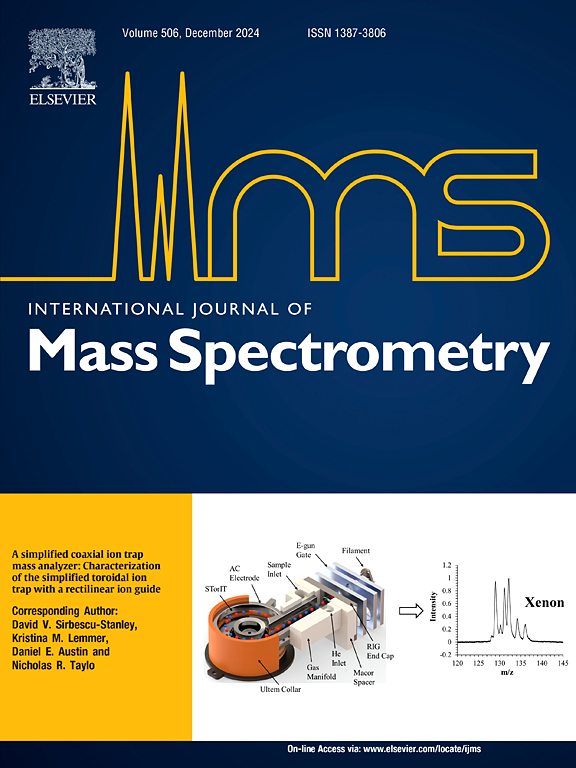Determining β-monosaccharide head group composition with high-resolution cyclic ion mobility separations coupled to tandem mass spectrometry as a first step for unknown cerebroside analysis
IF 1.7
3区 化学
Q3 PHYSICS, ATOMIC, MOLECULAR & CHEMICAL
引用次数: 0
Abstract
Cerebrosides, a class of biologically important lipids, are comprised of a monosaccharide head group along with their ceramide tail. However, their accurate characterization is challenging because of the isomerism in both the tail, from potential double bond positioning, or in the head from monosaccharide composition and α/β anomericity. In this work, we focused on tackling the identification of the β-monosaccharide head group, as either glucose or galactose, in various cerebroside isomers as well as demonstrating how our methodology could be applied to unknowns found in a porcine extract. To achieve this, we performed collision-induced dissociation prior to cyclic ion mobility separations to generate monosaccharide fragment ions from the starting cerebroside precursor ions. With this pre-cIMS CID approach, we observed that the cIMS separations of the fragment ions were diagnostic of the β-monosaccharide head group composition (i.e., glucose versus galactose), regardless of the ceramide tail length. From there, we demonstrated an example of how this methodology could also be applied to cerebrosides found in a porcine extract and a framework for how this approach could be added to existing workflows in developing collision cross section databases. Overall, we envision that our developed pre-cIMS CID-based approach will be a complementary and orthogonal tool to existing ones in glycolipidomics workflows.

高分辨率环离子迁移分离耦合串联质谱法测定β-单糖头基团组成作为未知脑苷分析的第一步
脑苷是一类生物学上重要的脂类,由单糖头部基团及其神经酰胺尾部组成。然而,它们的准确表征是具有挑战性的,因为在尾部,从潜在的双键定位,或在头部,从单糖组成和α/β异构性。在这项工作中,我们专注于在各种脑苷异构体中识别β-单糖头基团,即葡萄糖或半乳糖,并展示了我们的方法如何应用于猪提取物中发现的未知物质。为了实现这一点,我们在循环离子迁移分离之前进行了碰撞诱导解离,从起始的脑苷前体离子产生单糖片段离子。通过这种预cIMS CID方法,我们观察到片段离子的cIMS分离可诊断β-单糖头基团组成(即葡萄糖与半乳糖),而与神经酰胺尾部长度无关。从那里,我们展示了一个如何将这种方法应用于猪提取物中发现的脑苷的例子,以及如何将这种方法添加到开发碰撞截面数据库的现有工作流程中的框架。总的来说,我们设想我们开发的基于cims前cidd的方法将成为糖脂组学工作流程中现有方法的互补和正交工具。
本文章由计算机程序翻译,如有差异,请以英文原文为准。
求助全文
约1分钟内获得全文
求助全文
来源期刊
CiteScore
3.60
自引率
5.60%
发文量
145
审稿时长
71 days
期刊介绍:
The journal invites papers that advance the field of mass spectrometry by exploring fundamental aspects of ion processes using both the experimental and theoretical approaches, developing new instrumentation and experimental strategies for chemical analysis using mass spectrometry, developing new computational strategies for data interpretation and integration, reporting new applications of mass spectrometry and hyphenated techniques in biology, chemistry, geology, and physics.
Papers, in which standard mass spectrometry techniques are used for analysis will not be considered.
IJMS publishes full-length articles, short communications, reviews, and feature articles including young scientist features.

 求助内容:
求助内容: 应助结果提醒方式:
应助结果提醒方式:


